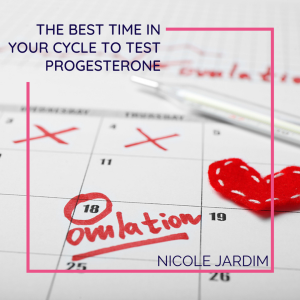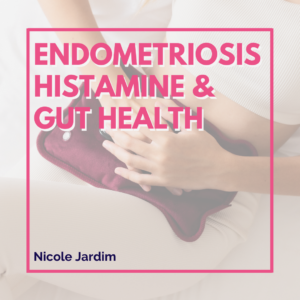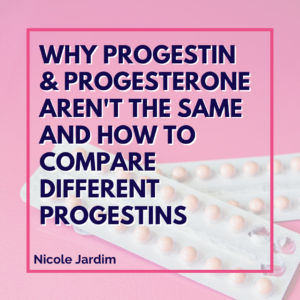You may have heard that the best time to test progesterone is on day 21 of your cycle. This is based on ovulation happening on day 14 of your cycle, and then testing 7 days after ovulation.
The thing is, very few of us ovulate on day 14, much less on a consistent basis. This means the optimal time to test is different for everyone. Why? Because we all have menstrual cycles of varying lengths.
The Length of a Menstrual Cycle
The length of your cycle is the number of days between periods, including the first day of your period until the day before your next period starts. This is determined by the length of your follicular phase and ultimately the day you ovulate.
There is a persistent belief that each and every menstrual cycle should be 28 days long, with ovulation occurring on day 14. That’s a HUGE generalization, however, and in reality, very few women have a consistent 28-day cycle.
The myth of the 28-day cycle probably stems back to the notion that women’s cycles were aligned with the 29-day cycle of the moon—and over the years, this widely-held belief has been perpetuated by things like the Rhythm Method, a calendar-based method of birth control dating back to the early 1900’s that follows the 28-day cycle rule, with ovulation occurring 14 days before the next period. Additionally, the widespread use of the birth control pill since the 60’s is likely a contributing factor as well, with its monthly dose of 28 neatly packaged pills to give you that “perfect” 28-day cycle.
Here are the facts: There are a lot of different views among practitioners regarding what a “normal” menstrual cycle length is, but studies show that a healthy cycle can fall within the range of 21-35 days, with an average cycle length of 29 days (1).
However, in my professional experience, a 25 to 35 day cycle is ideal for optimal hormone health and fertility. And when it comes to ovulation, contrary to popular belief, ovulation actually changes from cycle to cycle depending on a variety of factors. More often than not, I see it occur between days 12-21 of the cycle.
No Ovulation, No Progesterone
Progesterone only rises after you’ve already ovulated, which means that if you test too early (pre-ovulation), the results will not be an accurate representation of your hormonal health.
For example, if you were to test your progesterone levels in the follicular phase (before ovulation), you will most likely see a reading lower than 1.5 ng/mL. That’s practically nothing, because your body has not yet released an egg. Once that egg is released from its follicle on the ovary, the follicle turns into something called the Corpus Luteum which produces your progesterone for the rest of your cycle. Levels begin to increase just before the onset of the LH surge and then tend to peak 5 to 7 days after ovulation (2).
In other words, testing too early will tell you nothing about your progesterone—which is why it’s of utmost importance to test at the right time. (Therefore, there’s also no point in testing your levels while taking hormonal birth control, as it prevents ovulation and the production of progesterone.)
The Best Time to Check Your Progesterone Levels
So, all that said, when exactly is progesterone supposed to be tested? Progesterone should be tested 5-7 days after ovulation day. If you ovulated on day 16, you’d want to test on days 21, 22 or 23.
If you don’t know when you’ve ovulated, and you’re tracking your cycle, look at your app or chart and see when your period is due and count back 7 days. Test on that day.
Because of the 28-day cycle myth, what I see all too often is women being told to test their progesterone levels on Day 19, 20 or 21 of their cycle—which relies on the assumption that they ovulated on day 14—resulting in an inaccurately low result that leads them to believe they’re not ovulating at all (when in fact, they’re simply ovulating later).
But How Do I Know I’ve Ovulated?
I know what you’re thinking: Isn’t testing my progesterone supposed to tell me if I’ve ovulated or not? How else am I supposed to know?
The only way to confirm ovulation is to observe a temperature shift of at least 2/10’s of a degree and observe the change in cervical fluid from fertile quality (clear, stretchy, egg-white consistency) to post ovulatory cervical fluid (sticky and opaque or dry).
This is why I highly recommend charting your cycles using the Fertility Awareness Method AND using a high-quality cycle tracking apps like one of these.
Once you have a good idea that you’ve ovulated, you can take this at-home Progesterone Test to find out if your levels are normal. (Use coupon code Hormones20 to get 20% off all tests at Lets Get Checked!)
Post-Ovulation Progesterone Ranges
Okay, so now that you know WHEN to check your progesterone levels, it’s good to know the optimal range for progesterone during that post-ovulatory window.
The range in the luteal phase (after ovulation) is somewhere between 2-25 ng/mL. To confirm ovulation has occurred, progesterone levels in the middle of the luteal phase need to be above 7ng/mL (2), but I much prefer to see it higher between 15-25 ng/mL, which is an indicator of optimal progesterone production in the luteal phase.
A low mid-luteal progesterone level below 7ng/mL suggests that your cycle was anovulatory and no egg was produced. If it’s lower than 15ng/mL and you feel fine don’t stress!
However, if it is lower than 15ng/mL and you see mid-luteal or pre-period brown blood spotting, a short luteal phase (less than 10 days long), or symptoms such as anxiety or depression or other PMS or PMDD, or you’re having trouble getting or staying pregnant, it could mean you’re not producing a sufficient level of progesterone for your body.
My Progesterone Levels are Low. Now What?
Progesterone levels that are less than ideal can stem from a number of health issues, including thyroid disorders, hypothalamic amenorrhea (a lack of ovulation), or PCOS. But there’s hope! If you want to find AMAZING solutions to your particular hormonal imbalance, then I’ve got you covered in my Fix Your Period series of programs.
Ready to become your own health advocate and massively uplevel your period game? You’ll find the right program for you here!
*************
Sources:




3 thoughts on “The Best Time In Your Cycle to Test Progesterone”
I would like to get my progesterone tested, but I am having excessive periods (last month I had 3). How would you test in that scenario? Or would you just assume low progesterone?
I got it tested by my pcp in January, but my appointment wasn’t during the LH phase of my cycle, so the results were useless. It’s hard for me to set up the appointment in advance due to the irregularity/excessive periods.
Hi Susannah, I wouldn’t waste time with progesterone if you’re having three periods a month. Based on that, it’s highly unlikely you are ovulating or if you are, it’s not a high quality ovulation. That means that your progesterone is low. Focus on the basic foundational pieces of your health and start tracking your cycle using the method I describe in chapter 1 of my book Fix Your Period. Following this step by step protocol in the book is one of the best ways to improve your cycle.
This is timely for me. I spotted brown blood on day 21, and I really want to know why (I am now on day 24). If I ovulated, it was definitely day 13 or 14, as is typical for me, but I haven’t charted my temp for years, since before I got pregnant with my 3 year old. I hope I did not ovulate, but I also don’t feel like Pg is low. My boobs still hurt, so it was not a period. Hopefully the last option is either my Mirena was poking me (my first one perforated), or seed cycling that I’ve been doing the past two months is having effects. The obvious cause of brown blood on day 21 is too horrible to contemplate. If all is normal next cycle, I am definitely getting Pg tested.